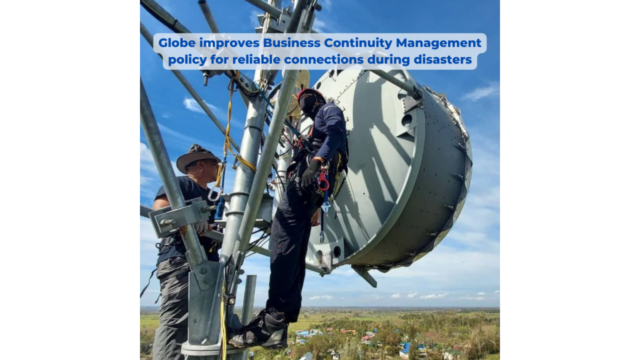Globe continues to strengthen its commitment to adapt to the impacts of climate change such as more violent typhoons, releasing an enhanced Business Continuity Management (BCM) policy to ensure dependable connectivity even during disasters and other catastrophic events.
“Recognizing the impacts of climate change and using innovative technologies to manage them makes Globe operationally resilient,” said Yoly Crisanto, Chief Sustainability and Corporate Communications Officer at the Globe Group. “Our commitment to our customers is to ensure that they stay connected especially in times of crisis. This updated BCM policy reaffirms our resolve to provide continuity of critical operations and delivery of key products and services to our customers whatever the situation may be.”
The BCM is part of a bigger Integrated Management System (IMS), which brings together the organization’s approach to energy, environment, health, and safety management. This alignment allows the consistent delivery of top-quality services, which contributes to Globe’s resilient network. The company’s ISO 22301 – Business Continuity Management is subject for recertification in 2024.
With the World Risk Index 2022 ranking the Philippines as the country most at risk from natural disasters, Globe’s role in ensuring uninterrupted connectivity is more critical than ever and reaffirms its commitment to providing reliable services to its customers.
The company is focused on strengthening its network infrastructure to be ready for disasters and prevent network disruptions. Its climate adaptation strategies include fitting key facilities with backup power generators with fuel enough for three to four days of operations, backup batteries that last four to eight hours, and backup communication devices such as satellite phones and radio networks.
It has also improved its infrastructure such as the installation of flood control gates, elevating base pads above typical flood levels, and designing towers to withstand high wind speeds as aligned with the National Structural Code of the Philippines (NSCP) 7th edition.
Globe also created G-Climate, an internal service that uses data to predict how typhoons might affect its cell sites. This tool allows it to prevent potential issues, keeping services running smoothly even during a storm. Plans are in place to roll this out across the nation by the end of the year.
The company also supports the National Disaster Risk Reduction and Management Council (NDRRMC), the Philippine Atmospheric, Geophysical and Astronomical Services Administration (PAGASA), and the Philippine Institute of Volcanology and Seismology (PHIVOLCS) by sending out disaster-related SMS alerts in line with Republic Act No. 10639, otherwise known as “The Free Mobile Disaster Alerts Act.” Its Regional Crisis Management Team is ready to jump in and help with recovery operations when necessary.
As part of its post-disaster or recovery response, Globe deploys Cell Site on Wheels (COW) and Tower on Wheels (TOW) used for Libreng Tawag at Libreng Charging (LTLC) stations in disaster-hit areas, especially in those placed under a state of calamity.
“Without doubt, climate change is one of the biggest challenges of our time. We will keep innovating and investing to ensure our network is most reliable for our customers, especially during disasters, when connectivity is crucial,” said Crisanto.
To learn more about Globe, visit https://www.globe.com.ph/.





